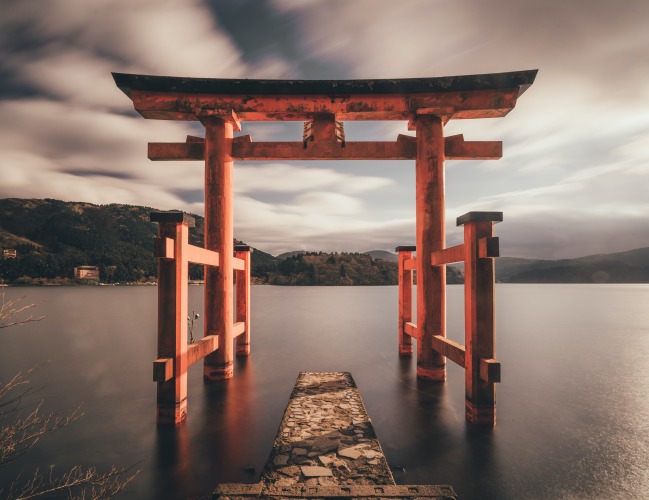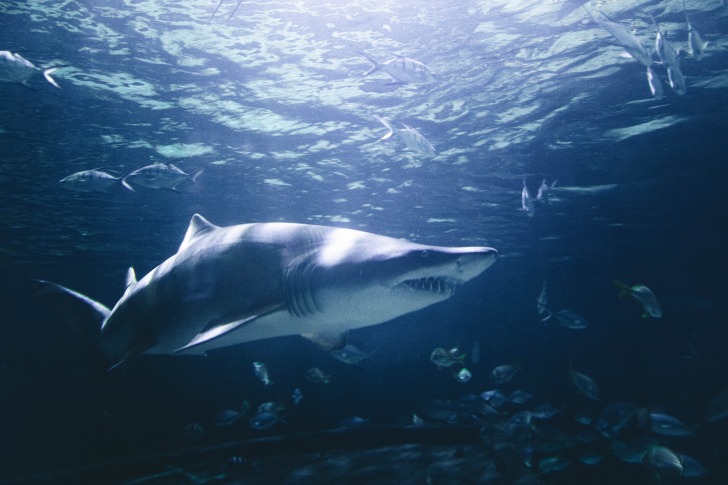There are all sorts of bodies of water in Japan, including the Sea of Japan.
If you’re going swimming, boating, or enjoying any other activities, it’s important to know if there are sharks in Japan.
By taking the time to learn about the presence of sharks and what species you may encounter, you can keep yourself safe.

Contents
So… Are There Sharks in Japan?
With over 400 species of sharks found around the world, there will be sharks found in some different areas of Japan.
There are freshwater and saltwater species of sharks, though you’ll primarily only find saltwater species in Japan.
In the areas of Chubu, Kanto, and Okinawa, you can find schools of scalloped hammerhead sharks – and these schools can include up to 100 sharks at a time.
Specifically, you’ll see them around Mikomoto Island, the Izu islands, and Yonaguni island.
If you are swimming around the Nanpo Islands or around the Mugi area, you might be more likely to encounter thresher sharks.
Mikomoto Island, where there are schools of hammerhead sharks, is a popular place for boating and swimming.
With all of the sandbars, it can be a regular hangout for many types of sharks in the water.
Some are more frequently spotted than others – and many won’t be visible unless you’re deep-diving.
If you spend enough time in Japan, whether you’re on a fishing pier, on a boat, or sitting on a beach, you’re likely to spot sharks.
Unlike other parts of the world, sightings are quite common – though there aren’t a large number of attacks.
Approximately 130 species of sharks are found in Japan.
These include coastal sharks that enjoy the temperate zone as well as some of the oceanic and bottom-living sharks that are only found in deep depths.
Two species found in Japan are on the endangered list, which includes the scalloped shark and the great hammerhead.
There are some species that are more common than others, and it also depends on the region where you will be spending your time.
Some of the more common species of sharks you’re likely to encounter in Japan include:
- White-tip reef sharks
- Whale sharks
- Pelagic thresher sharks
- Japanese bullhead sharks
- Japanese-banded houndsharks
- Sand tiger sharks
- Blacktail reef sharks
- Tiger sharks
- Oceanic black tip sharks
Marine biologists and oceanographers are still researching sharks, so there are many species where not a lot is known about them.
Most of the sharks that you will find throughout Japan are not likely to attack.
The most aggressive ones that you will have to deal with include tiger sharks and hammerhead sharks.
The deadliest shark in the world is the great white – and these are rarely found in any of the waters around Japan.
Is It Safe to Swim in Japan?
It is safe to swim in various parts of Japan, but it’s important to note which body of water you want to be in.
With as many species of sharks found in the water, particularly around some of the Pacific islands, you’ll want to exercise extreme caution.
Only a few of the species are not known to attack, including the whale shark and thresher shark.
Many people in Japan don’t swim in the water because there are no lifeguards in many bodies of water.
As such, unless there is a lifeguard present, you won’t see people going into the water.
There are a few beaches that are popular for swimming, and many are within an hour of Tokyo.
This includes:
- Yuigahama Beach (Kanagawa)
- Zushi Beach (Kanagawa)
- Okinoshima Swimming Area (Chiba Prefecture)
- Suma Beach (Hyogo Prefecture)
- Yonahamaehama Beach (Miyakojima)
- Manza Beach (Okinawa Island)
It’s important to note that there is other marine life that can be dangerous beyond sharks.
Various species of sting rays are found in the water, including the eagle ray and the reef manta ray.
While the manta ray does not have a barb on the tail, the eagle ray has venous tail spines that can inflict serious wounds.
Beyond dangers in the water, you also have to look out for some aspects that are unique to Japan.
Particularly if you’re looking to swim around some of the archipelago islands, check for seismic activity.
It is possible for volcanoes to erupt.
Earthquakes and tsunamis are also possible.
While some are small, others are not – and you’ll want to follow the various evacuation procedures whenever you see them.
Typhoons are another problem, particularly in the tropical regions around the Pacific Ocean.
If you are going to swim, be sure that you follow the weather bulletins and tell others where you will be.
Wild swimming, also known as open-water swimming can be extremely dangerous.
It’s best to swim where there are lifeguards or where it is commonplace for people to swim so that you don’t encounter any problems – either with the marine life or with the environment around you.

Interesting Shark Facts in Japan
Sharks are often referred to as “fuka,” particularly in the Kansai area of Japan.
The character is a mix of “fish” and “bring up,” which represents that some shark species will carry their young before birth.
Sharks have been used in a variety of different ways throughout history in Japan.
The flesh can be ground up and reconstituted into various shapes, colors, and textures.
The fins have also been used in the cosmetic industry because they are rich in collagen.
The skin of a shark is also used as a grater when serving wasabi.
Even shark liver oil is sold due to the concentration of vitamins A and D, so it can be found as a nutritional supplement.
If you want to experience sharks while you’re in the water, Chiba Prefecture offers a diving attraction that is known as “Tateyama-Ito’s Shark Scramble” or “Shark City.”
It is where you have the ability to dive with hundreds of banded hound sharks when there is a feeding/chumming session.
Yonaguni Island is where you can participate in “hammerhead dives” that require a negative entry.
There will be teams and guides to spot the hammerheads.
Once they’re spotted, divers have the ability to dive up to 40 meters depending on experience.
The most common type of shark you’ll likely see is the white-tip reef shark.
These are easily found because they are smaller sharks that are brownish gray with conspicuous white tips found on the caudal and dorsal fins.
They are typically not aggressive toward humans, which is why they are commonly observed in the waters and especially around some of the caves of Okinawa.
With sharks being so common throughout Japan, they are also seen in the jewelry scene.
Shark teeth can wash up on shore, so many people will use them to create shark tooth bracelets and necklaces.
Others will use the shark as a symbol when creating totems, brooches, and enamel jewelry.
Most of the shark species of the world prefer warm, saltwater habitats.
They need the salt within their cells to maintain the salt concentration of their blood.
If they don’t get enough salt, they can become bloated and die.
Over the years, some sharks have been able to evolve.
They hold more salt in their cells, allowing them to venture into freshwater areas.
Only a few freshwater sharks exist in the world.
These include:
- Speartooth sharks
- Ganges sharks
- Borneo river sharks
- Bull sharks
Most of the freshwater species are found around India.
The Japanese bullhead shark is found in freshwater, but there is usually nothing to worry about with these.
They are slow-swimming and docile.
They typically eat shelled invertebrates and small bony fish.
Knowing this, your only threat will be found in saltwater bodies of water across Japan.
3 Safety Tips for Swimming in Shark-Infested Waters
If you’re going to go into the water, find out if they are shark-infested ahead of time.
If they are, stay out of the water so that you eliminate your risks entirely.
If you do go into the water, follow a few safety tips.
1. Don’t Enter the Water Alone
Sharks will attack a lone swimmer long before attacking a group.
They’ll see you as an easy target.
Instead, enter the water with a group so that sharks will think twice about coming near you.
2. Don’t Enter if You’re Bleeding
If you’re bleeding from even the tiniest of wounds (or women, if you’re menstruating), don’t enter the water.
Sharks are attracted to blood and can smell it in the water from as far as three miles away.
3. Avoid Provoking the Sharks
Sharks are much more likely to attack if they’re being provoked.
Don’t yell at them, splash around or attempt to touch them.
If you see one in the water, remain calm and slowly move away from them – preferably toward a boat or the shoreline.
Summary
Sharks are abundant throughout Japan, especially since there are over 100 species in the waters.
You won’t find all of the species unless you’re diving into the depths of the water, but there is enough swimming where you may swim to exercise plenty of caution.
The Japanese culture believes in following the rules, and many are taught not to swim unless there is a lifeguard.
This can be good advice so that you avoid wild swimming.
If you want to see sharks, there are plenty of diving experiences where you can go with an experienced tour guide and swim with the sharks without risking your life.
Japan Safety Overview
READ THE FULL REPORT: Japan Safety Review
Safety Index:
- OVERALL RISK: LOW
- TRANSPORT & TAXIS RISK: LOW
- PICKPOCKETS RISK: LOW
- NATURAL DISASTERS RISK: MEDIUM
- MUGGING RISK: LOW
- TERRORISM RISK: LOW
- SCAMS RISK: LOW
- WOMEN TRAVELERS RISK: LOW
Frequently Asked Questions
How many shark attacks take place every year?
Approximately 75 shark attacks happen around the world every year.
Only about four people will die from such attacks.
In Japan, there were only 27 recorded attacks between 1862 and 2016.
Where’s the safest place to swim?
It’s best to swim in areas where there is a lifeguard and where the water doesn’t get too deep.
What is the largest shark in Japan?
The largest shark found in Japan is the Pacific sleeper shark.
It is unlikely that you will encounter these sharks because they live in some of the deep waters outside of Tokyo Bay where the temperatures are much colder.
Where are sharks more likely to hang out?
If there is a sandbar or a steep drop-off in the water, sharks are more likely to be there.
As such, you need to exercise more caution in such locations.
How do you survive a shark attack?
Surviving a shark attack is all about not overthinking the situation.
Fight to ensure you survive and keep your limbs away from its snout.
Try to swim toward land.
If you’re close to being bitten, gouge its eyes or gills so that you can make a getaway.











